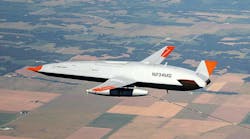By John Keller, chief editor Military & Aerospace Electronics
The U.S. Department of Defense (DOD) budget request for fiscal year 2005 has a lot of bright spots for military and aerospace electronics and optoelectronics, yet the overall funding picture is a mixed bag with several alarming cuts on the horizon.
Let's start at the beginning. There is a widely held perception that defense spending in our nation is increasing at a respectable clip. Don't believe it; defense spending is as flat as can be.
For the current fiscal year, DOD leaders asked Congress for $399.1 billion, which would pay for nearly everything military, except for the U.S. Department of Energy's nuclear weapons programs, and for congressional supplemental appropriations to keep up military operations in Iraq, Afghanistan, and throughout the Middle East region.
Compare that amount with the Pentagon's request for fiscal year 2005, which begins Oct. 1. For next year DOD leaders are asking Congress for $401.7 billion. That represents an increase over this year of only $2.6 billion, or 0.6 percent. That doesn't sound like much growth to me.
There is even more cause for concern when we try to gauge what the DOD budget means for future electronics and optoelectronics spending.
The three parts of the military budget with the most electronics and optoelectronics content are procurement, research and development, and operations and maintenance. Procurement essentially involves purchasing weapons and support systems, research seeks to develop the technology for future generations of weapons, and operations and maintenance involves replacing components lost or worn out during normal military operations.
Next year DOD wants $74.9 billion for procurement, which is down $6.2 billion — or 7.8 percent — from this year's request of $81.1 billion. Research and development is a different story.
Next year DOD wants $68.9 billion, which us up $4.2 billion — or 6.2 percent — from this year's level of $64.7 billion. Operations and maintenance, however, would see a steep drop next year to $140.6 billion, which is down $33.76 billion — or 19.3 percent — from this year's level of $174.3 billion.
Let's take a closer look at procurement, where the electronics and optoelectronics content is relatively easy to spot. The big electronics areas are electronics, communications, and telecommunications equipment; aircraft procurement and aircraft modifications; and missile procurement and missile systems modifications.
For this year the Pentagon asked for $7.3 billion for electronics and communications, but next year that request is down $1.2 billion — or a drop of $16.5 percent — to $6.1 billion. This part of the budget involves things like command-and-control systems, computers, sensors, and satellite communications. It is perhaps the most electronics-rich portion of the procurement budget.
Military aircraft also are huge users of electronics and optoelectronic systems. Next year the Pentagon is asking for $16.2 billion, which is up $1.2 billion — or 6.7 percent — from this year's level of $15.2 billion.
Modifications to military aircraft can contain large amounts of electronics, as the upgrades often involve putting new avionics into existing airframes. For next year the Pentagon wants $4.7 billion for aircraft modifications, which is down $357.5 million — or 7 percent — from this year's level of $5.1 billion.
Missile systems also are substantial users of electronics, for guidance and control. Next year the Pentagon wants $2.5 billion for missile procurement, which is down by $287.9 million — or 10.4 percent — over this year's level of $2.8 billion.
It is a brighter story for missile modifications, however, as DOD is asking for $1.5 billion next year for missile modifications, which is up $134.7 million — or 8.8 percent — over this year's level of $1.4 billion.
Individual bright spots for electronics in the DOD's procurement budget include increased spending for the U.S. Army's UH-60 helicopter modifications, the Army's M1A2 main battle tank upgrades, and the Army's Joint Tactical Radio System Cluster 1. The U.S. Navy's procurement budget includes increases for the KC-130J turboprop tanker aircraft, F-18-series aircraft, and submarine periscopes and imaging equipment.
Other cuts in the procurement budget would involve Army tracked combat vehicles and night-vision devices; the Navy's shipbuilding and conversion program as well as that service's Joint Direct Attack Munition; and the Air Force's Predator unmanned vehicle system.
Increases in the U.S. Air Force's procurement budget would go for the Joint Direct Attack Munition, the Small-Diameter Bomb, physical security, and the Air Force Base Information Infrastructure.


